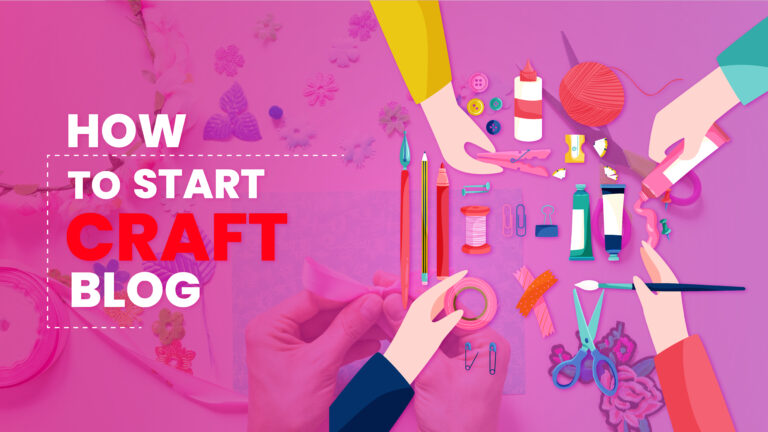In 2026, creativity has gone digital and craft blogging has become one of the most inspiring ways to share that creativity with the world. Whether you love DIY home decor, paper crafts, handmade jewelry, or sustainable art projects, starting a craft blog allows you to showcase your passion, teach others, and even build a profitable online brand.
A craft blog isn’t just about posting pretty pictures of your projects it’s about telling stories, offering tutorials, and connecting with a community of makers who share your enthusiasm for creating something beautiful from scratch. With the right tools, strategy, and consistency, you can turn your love for crafting into a thriving blog that attracts readers, inspires creativity, and earns real income.
Step-by-Step Guide to Starting a Craft Blog
1. Define Your Purpose and Craft Niche
To create a focused blog, start by defining the type of crafts you want to write about. Do you specialize in knitting, embroidery, paper crafts, or mixed media? Your niche is important because it sets you apart from other craft bloggers. For example, you could focus on eco-friendly crafts, upcycling, or holiday-themed projects. Being clear about your niche helps attract the right audience who share an interest in that particular craft.
When choosing your niche, think about your skills, what you’re passionate about, and where you see potential to stand out. Look at existing blogs in your field and assess gaps where you can offer unique perspectives or ideas. This will help you position your blog effectively in a competitive market.
2. Choose a Blog Name and Domain:
Your blog name should reflect your craft focus and personality. It should be catchy, memorable, and relevant to the type of content you’ll be publishing. Once you have a name in mind, check for domain availability. Platforms like Namecheap and GoDaddy allow you to search for available domain names and register them. Having your own domain (e.g., www.yourcraftblog.com) gives your blog a professional feel and improves search engine optimization (SEO).
When choosing a domain, keep it simple and avoid complicated spellings or long names. A clear and concise domain is easier for readers to remember and for search engines to crawl.
3. Select a Blogging Platform:
The next step is to select a blogging platform that meets your needs. WordPress.org is one of the most popular and versatile platforms. It offers a wide range of customization options and plugins that allow you to optimize your blog for SEO, social sharing, and monetization. Other platforms, such as Wix or Squarespace, may be more beginner-friendly, but they offer limited customization compared to WordPress.
opts for WordPress if you’re serious about growing your blog. With its extensive library of themes and plugins, it allows you to customize your blog’s design and functionality without needing advanced coding skills. You can find craft-specific themes that align with the aesthetic of your content.
4. Set Up Hosting for Your Blog:
Once you’ve selected a platform, you need web hosting. Hosting services like Bluehost, Site Ground, and Dream Host offer affordable options to host your blog. Hosting providers store your blog on their servers and ensure that your site is accessible to visitors. Many hosting companies offer one-click WordPress installation, which makes it easier to get your blog up and running.
Choose a reliable hosting service with good uptime and customer support. Consider performance, security, and cost when selecting a hosting plan. Some hosting providers offer packages that include a free domain name for the first year.
5. Design Your Blog:
The design of your craft blog is crucial. A visually appealing, user-friendly blog invites visitors to stay longer and explore your content. Choose a theme that reflects your craft style. Many WordPress themes are fully customizable, meaning you can adjust colors, fonts, layouts, and more. If you’re not confident in designing the blog yourself, consider hiring a designer to ensure your blog looks polished and professional.
In addition to visual aesthetics, prioritize functionality. Ensure your blog is easy to navigate, with clear categories for different types of crafts or projects. A responsive design that looks good on both desktop and mobile devices is important for user experience and SEO.
6. Plan and Create Content:
Content is the heart of your craft blog. Start by creating a content plan that outlines your first few posts. Think about tutorials, project ideas, tool reviews, or even personal stories about your crafting journey. High-quality photos are key to a craft blog, as readers often look for visual inspiration. Invest in a good camera or learn basic photography techniques to enhance your posts.
When creating tutorials, be detailed and provide step-by-step instructions. Visual aids, like images or videos, make it easier for readers to follow along. The more value you provide through your content, the more likely you are to build a loyal audience.
7. Optimize For SEO:
Search engine optimization (SEO) is important for driving traffic to your blog. SEO helps your blog rank higher in search engine results pages (SERPs) when users search for topics related to your content. Start by researching relevant keywords that people might use to find your blog. Tools like Google Keyword Planner and Ahrens can help you identify high-ranking keywords for your niche.
Use these keywords strategically in your blog posts, headings, meta descriptions, and image alt tags. Remember that search engines prioritize content that is informative, relevant, and well-structured. Internal linking between related posts and using external links to authority sites can also improve your blog’s SEO.
8. Promote Your Blog on Social Media
Social media is a powerful tool for promoting your craft blog. Platforms like Pinterest, Instagram, and Facebook are perfect for sharing visual content. Create accounts for your blog and regularly post images, tutorials, or short videos of your craft projects. Pinterest, in particular, is a valuable platform for craft bloggers, as it allows users to share and discover ideas through pinboards.
Be consistent with posting and engaging with your audience on social media. Use relevant hashtags to reach a broader audience and connect with other craft enthusiasts. Social media can drive significant traffic to your blog if used strategically.
9. Monetize Your Blog:
Once your blog gains traction, you can explore monetization opportunities. Popular ways to monetize a craft blog include affiliate marketing, sponsored content, and selling your own craft products. Affiliate marketing involves partnering with brands and earning a commission when your readers make purchases through your referral links. You can promote tools, craft supplies, or platforms like Etsy.
Additionally, consider selling your own craft kits, patterns, or tutorials. You can also offer online workshops or classes to teach others your crafting techniques. Sponsored content with brands that align with your niche is another way to earn income while maintaining the integrity of your blog.
10. Engage With Your Readers:
Building a community around your blog is essential for long-term success. Engage with your readers by responding to comments, answering questions, and asking for feedback. Encourage your audience to share their own craft projects or ideas, creating a collaborative environment. You can also create a newsletter to keep your readers updated on new posts, exclusive content, and upcoming events.
A loyal and engaged audience is more likely to share your blog with others, helping you grow your reach. Hosting giveaways, challenges, or guest posts from other crafters can further boost engagement and keep your audience interested.
Tips to Grow Your Craft Blog in 2025
In 2024, competition in the blogging world is high, but there are several strategies you can implement to stand out and grow your craft blog:
- Collaborate with Other Bloggers: Partner with other craft bloggers for guest posts or joint projects. This expands your reach and introduces your blog to a new audience.
- Create a YouTube Channel: Video content is increasingly popular, and starting a YouTube channel alongside your blog can showcase tutorials and projects in a more engaging way.
- Offer Downloadable Resources: Create free printables, patterns, or guides that readers can download when they subscribe to your newsletter. This helps build your email list and keeps readers coming back for more.
- Attend Craft Events: Attend or even host local or virtual craft events. Networking with other crafters and enthusiasts can help build your brand and blog’s reputation.
- Stay Consistent: Consistency is key in blogging. Post regularly, maintain your social media presence, and continue to produce high-quality content to grow your audience over time.
Conclusion:
Starting a craft blog in 2025 is a rewarding journey for anyone passionate about creativity and art. By following this step-by-step guide, you can establish a blog that not only showcases your craft but also inspires and educates others. Focus on providing valuable content, optimizing for SEO, and engaging with your audience to build a thriving online craft community. With dedication and consistency, your blog can become a go-to resource for craft lovers worldwide.
Frequently Asked Questions (FAQs)
How long does it take to start a craft blog?
Setting up a craft blog can take a few days to weeks, depending on how much time you dedicate to designing the site, creating content, and promoting it. The key is to plan and take each step methodically.
Do I need to be an expert in crafts to start a blog?
No, you don’t need to be an expert. However, having some level of experience or passion for the craft you blog about helps you produce authentic, valuable content that resonates with readers.
How do I make money from my craft blog?
You can monetize your blog through affiliate marketing, selling craft-related products, offering paid tutorials or workshops, and collaborating with brands for sponsored posts.
Which platform is best for starting a craft blog?
WordPress.org is highly recommended for its flexibility, customization options, and wide range of plugins that help optimize your blog for SEO and performance.
What types of content should I post on my craft blog?
Post a mix of tutorials, project ideas, tool reviews, and personal crafting stories. High-quality images and detailed instructions are essential for engaging content.


No Comments
Hi there, I found your site via Google even as searching for a related matter, your website came up, it appears to be like great. I’ve bookmarked it in my google bookmarks.
Your comment is awaiting moderation.